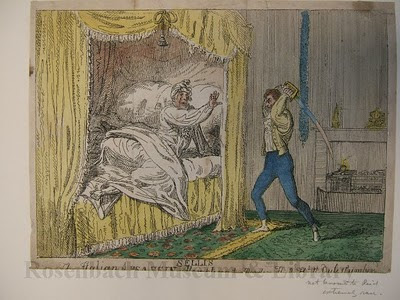This is a guest post by Rosenbach Collections Intern Jessica Walthew
Even the most industrious researcher can be waylaid by a red herring. Today we’ll relate the tale of “The Italian Assassin” and the clues that led (and misled) the collections and library staff at the Rosenbach to discover the story behind this George Cruikshank print. The print in question shows a man brandishing a saber at a man in bed, and the catalog record records the inscription at the bottom as “S. ELLIS/ The Italian Assassin”. The rest of the inscription is cut in half vertically and is hard to make out. There is also an enticing handwritten note “not known to Reid, extremely rare,” which is guaranteed to ignite the imagination of a researcher. This hand-colored etching is part of the large collection of Cruikshank illustrations here at the Rosenbach, which Kathy discussed in her last post. It fell to me, as a collections intern, to see what I could find about the subject and date of this lovely little print. Some cursory research on Cruikshank reveals that he published a book called Italian Tales in 1824, but it contained 16 full page woodcuts, not etchings. Though there are several good catalogues, looking into all known Cruikshank illustrations would be a huge task, as he was incredibly prolific. As an aside, Dr. Rosenbach himself wrote a guide to the Cruikshank materials in the Widener Collection, now at Harvard. In order to narrow down my focus, I tried searching for a connection between “S. Ellis” and Cruikshank, which led me to an author named Sarah Stickney Ellis. But what connection could there be between Mrs. Ellis, author of The Women of England: their social duties and domestic habits and The Italian Assassin? Cruikshank may have illustrated her book My brother, or The man of many friends (1855), but this somewhat promising lead turned out to be a dead end. I thought it was time to put this mystery into my ever-growing pile of unsolved cases, but luckily, Elizabeth, the Rosenbach’s librarian, thought to quickly try searching for “Sellis” rather than S. Ellis, to see if anything might turn up—and turn up it did! Joseph Sellis was a valet of Ernest Augustus, Duke of Cumberland (later King of Hanover). On May 31st, 1810, the Duke was awoken by some stirrings in his chamber and found himself under attack. The would-be assassin, intent on chopping off the Duke’s head, somehow managed to hit the Duke’s sword instead and fled upon realizing his failure. (What the sword was doing so near to the sleeping Duke is another question.) The Duke called in one of his servants and had him go to fetch Sellis, who was found lying dead on his bed. The official story was that Sellis had attempted to kill the Duke and had committed suicide after returning to his room, but rumors abounded. Suspicions arose because Sellis was found nearly decapitated in his room, his wounds a little extreme to be self-inflicted. The washbasin in Sellis’ room was also tainted with bloody water, and it’s quite unlikely that Sellis would have slit his own throat, washed his hands, and only then settled down to die. As the Duke was fairly unpopular, naturally, many people suspected him of offing his own servant and then inventing the botched assassination as a cover. Among the rumors was that the Duke had had an affair with Sellis’ wife, or was having an affair with his other valet (the one who discovered Sellis’ dead body). He was also later accused of siring a son by his sister. The Duke had, in fact, married his first cousin in typical royal fashion, but most of these rumors were attributed to political maneuverings and even his quarrels with Queen Victoria didn’t prevent him from living happily as King of Hanover until his death in 1851. And to think, this interesting story might never have come to our attention had Elizabeth not noticed the potential mis-transcription of S.ELLIS for SELLIS. Armed with our knowledge of the backstory, the full inscription can be made out as “SELLIS/ The Italian Assassin Attempting to Murder H.R.H. The Duke of Cumberland.” What a difference one little period can make! * the Duke successfully won a libel suit against one of the publishers of the scandalous rumorsP.S. (From Kathy) Click here to see another interesting Cruikshank print involving Sellis and the Duke.


This same Duke of Cumberland was the owner of the Paul Storr candelabrum in the Rosenbach's diningroom.